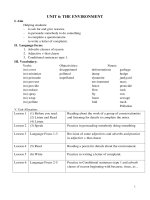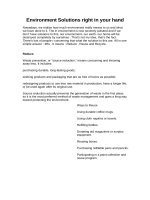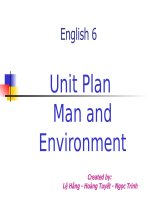External Environment
Bạn đang xem bản rút gọn của tài liệu. Xem và tải ngay bản đầy đủ của tài liệu tại đây (580.76 KB, 38 trang )
External Environment
Techno MBA 과정
조안기
Purpose of This Chapter
Identify the organizational domain
Identify the sectors that influence the organization
Explorer two major environmental forces on the
organization
The need for information
The need for resources
Environmental Domain
Organizational environment
All elements that exist outside the
boundary of the organization
All elements have the potential to affect all
or part of the organization
Organization’s Environment
(a)
Industry
Sector
(i)
International
Sector
DOMAIN
(b)
Raw
Materials
Sector
(h)
Sociocultural
Sector
(c)
Human
Resource
Sector
(h)
Government
Sector
(d)
Financial
Resource
Sector
ORGANIZATION
(g)
Economic
Condition
Sector
(f)
Technology
Sector
(e)
Market
Sector
Task Environment
The task environment includes sectors with which the
organization interacts directly and that have a direct
impact on the organization’s ability to achieve its
goals
(a) Industry sector
Competitors, industry size and competitiveness, related
industries
(b) Raw materials sector
Suppliers, manufacturers, real estate, services
(e) Market sector
Customers, clients, potential users of products and
services
(c) Human resources sector
Labor market, employment agencies, universities,
training schools, empolyees
(j) International sector
Competition from and acquisition by foreign firms, entry
into overseas markets, foreign customers, regulations
General Environment
The general environment includes those sectors that
might not have a direct impact on the daily operations
of a firm but will indirectly influence it
(h) Government sector
City, state, federal laws and regulations, taxes, services,
court system, political processes
(i) Sociocultural sector
Age, values, beliefs, education, religion, work ethic,
consumer and green movements
(g) Economic conditions sector
Recession, unemployment rate, inflation rate, rate of
investment, economics, growth
(f) Technology sector
Techniques of production, science, computers,
information technology, e-commerce
(d) Financial resource sector
Stock markets, banks, savings and loans, private
investors
International Context
The international sector can directly affect many
organizations
The distinctions between foreign and domestic
operations have become in creasingly irrelevant
The growing importance of the international sector
means that the environment for all organizations is
becoming extremely complex and extremely
competitive
Environmental Uncertainty
How does the environment influence an organization?
The patterns and events occurring in the environment
can be described along several dimensions, such as
whether the environment is stable or unstable,
homogeneous or heterogeneous, simple or complex
These dimensions boil down to two essential ways the
environment influences organizations
(1) the need for information about the environment
The environmental conditions of complexity and chage
create a greater need to gather information and to respond
based on that information
(2) the need for resources from the environment
The organization also is concerned with scarce material and
financial resources and with the need to ensure availability
of resources
Sectors of the general environment can create
uncertainty for organizations
Determining an organization’s environmental
uncertainty generally means focusing on sectors of
the task environment
Uncertainty means that decistion makers do not have
sufficient information about environmental factors,
and they have a difficult time predicting external
chages
Simplex-Complex Dimension
The simple-complex dimension concerns
environmental complexity
Aerospace firms and universities in a complex
environment
Family-owned hardware store in a simple environment
Stable-Unstable Dimension
The stable-unstable dimension refres to whether
elements in the environment are dynamic
Although environments are more unstable for most
organizations today
A traditionally stable environment is a public utility
Framework
Simple + Stable =
Low Uncertainty
Complex + Stable =
Low-Moderate Uncertainty
1. Large number of external
elements, and elements are
dissimilar
1. Small number of external elements
and elements are similar
Stable
Examples : Soft drink bottlers,
Beer distributors,
Container manufacturers,
Food processors
2. Elements remain the same or
change slowly
U
e
nc
nt
ai
y
Simple + Unstable =
High-Moderate Uncertainty
Examples : Universities,
Appliance manufacturers
Chemical companies,
Insurance companies
rt
ENVIRONMENTAL
CHANGE
2. Elements remain the same or
change slowly
Complex + Unstable =
High Uncertainty
1. Small number of external
elements, and elements are
similar
1. Large number of external
elements, and elements
are dissimilar
2. Elements change frequently and
2. Elements change frequently
and unpredictably
Examples : E-commerce,
Fashion clothing,
Music industry,
Toy manufactures
Examples : Computer firms,
Aerospace firms,
Telecommunications firms,
Airlines
Unstable unpredictably
Simple
Complex
ENVIRONMENTAL COMPLEXITY
Adapting to Environment
Uncertainty
In this section we discuss in more detail how the
environment affects organizations
Positions and Departments
As the complexity and uncertainty in the
external environment increases, so does the
number of positions and departments within
the organization, which in turn increases
internal complexity
The human resource departments deals with
unemployed people who want to work the company
The marketing department finds customers
Procurement employees obtain raw materials from
hundreds of suppliers
The finance group deals with bankers
The legal department works with the courts and
government agencies
Buffering and Boundary Spanning
Buffering
The traditional approach to coping with
environmental uncertainty was to establish
buffer departments
The purpose of buffering roles is to absorb
uncertainty from the environment
A newer approach some organizations are
trying is to drop the buffers and expose the
technical core to the uncertain
environment
Boundary-spanning roles
Link and coordinate an organization with key elements in
the external environments
(1) Detect and bring into the organization information
about changes in the environment
(2) Send information into the environment that presents
the organization in a favorable light
On new approach to boundary spanning is business
intelligence, which refers to the high-tech analysis of large
amounts of internal and external data to spot patterns
and relationships that might be significant
Business intelligence is related to another important area
of boundary spanning, known as competitive intelligence
(CI)
In today’s turbulent environment, many successful
companies involve everyone in boundary-spanning
activities
Differentiation and Integration
Another response to environmental
uncertainty is the amount of differentiation
and integration among departments
When the external environment is complex
and rapidly changing, organizational
departments become highly specialized to
handle the uncertainty in their external sector
When the environment is highly uncertain,
frequent changes require more information
processing to achieve horizontal coordination,
so integrators become a necessary addition
to the organization structure
Industry
Plastics
Foods
Contain
er
Environmental uncertainty
High
Moderat
e
Low
Departmental differentiation
High
Moderat
e
Low
Percent management in integrating
roles
22%
17%
0%
Organic versus Mechanistic
Management Processes
Mechanistic organization system
When the external environment was stable,
the internal organization was characterized
by rules, procedures, and a clear hierarchy
of authority
Organization were formalized
They were also centralized, with most
decisions made at the top
Organic organization system
In rapidly changing environments, the
internal organization was much looser,
free-flowing, and adaptive
Rules and regulations often were not
written down or, if written down, were
ignored
The hierarchy of authority was not clear
Decision-making authority was
decentralized
Mechanistic
1. Tasks are broken down into
specialized, separate parts
2. Tasks are rigidly defined
3. There is a strict hierarchy of
authority and control, and there are
many rules
4. Knowledge and control of tasks are
centralized at the top of the
organization
5. Communication is vertical
Organic
1. Employees contribute to the
common tasks of the department
2. Tasks are adjusted and redefined
through employee teamwork
3. There is less hierarchy of authority
and control, and there are few rules
4. Knowledge and control of tasks are
located anywhere in the organization
5. Communication is horizontal
Planning, Forecasting, and
Responsiveness
It might seem that in an environment where everything
is changing all the time, planning is useless
However, in uncertain environments, planning and
environmental forecasting actually become more
important as way to keep the organization geared for a
coordinated, speedy response
When the environment is stable, Long-range planning
and forecasting are not needed.
With increasing environmental uncertainty, planning and
forecasting become necessary
Planning, however, cannot substitute for other actions,
such as effective boundary spanning and adequate
internal integration and coordination
Framework for Organizational
Responses to Uncertainty
Low Uncertainty
Low-Moderate Uncertainty
1. Mechanistic structure :
formal, centralized
1. Mechanistic structure :
formal, centralized
Stable
2. Many departments, some
boundary spanning
2. Few departments
3. No integrating roles
3. Few integrating roles
4. Current operations orientation;
low-speed response
e
nc
rt
y
High-Moderate Uncertainty
nt
ai
Unstable
U
ENVIRONMENTAL
CHANGE
4. Some planning; moderate-speed
response
High Uncertainty
1. Organic structure, teamwork :
participative, decentralized
1. Organic structure, teamwork :
participative, decentralized
2. Few departments, much
boundary spanning
2. Many departments differentiated,
extensive boundary spanning
3. Few integration roles
3. Many integration roles
4. Planning orientation; fast
response
4. Extensive planning, forecasting;
high-speed response
Simple
Complex
ENVIRONMENTAL COMPLEXITY









